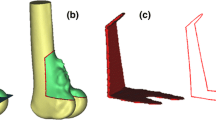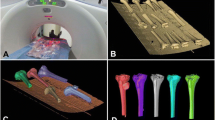Abstract
Clinical reports suggest that large bone defects could be effectively restored by allograft bone transplantation, where allograft bone selection acts an important role. Besides, there is a huge demand for developing the automatic allograft bone selection methods, as the automatic methods could greatly improve the management efficiency of the large bone banks. Although several automatic methods have been presented to select the most suitable allograft bone from the massive allograft bone bank, these methods still suffer from inaccuracy. In this paper, we propose an effective allograft bone selection method without using the contralateral bones. Firstly, the allograft bone is globally aligned to the recipient bone by surface registration. Then, the global alignment is further refined through band registration. The band, defined as the recipient points within the lifted and lowered cutting planes, could involve more local structure of the defected segment. Therefore, our method could achieve robust alignment and high registration accuracy of the allograft and recipient. Moreover, the existing contour method and surface method could be unified into one framework under our method by adjusting the lift and lower distances of the cutting planes. Finally, our method has been validated on the database of distal femurs. The experimental results indicate that our method outperforms the surface method and contour method.





Similar content being viewed by others
Notes
Two sequential surface registrations are equivalent to one surface registration with more iterations.
References
Besl PJ, McKay ND (1992) Method for registration of 3-d shapes. In: Robotics-DL tentative, international society for optics and photonics, pp 586–606
Bousleiman H, Paul L, Nolte LP, Reyes M (2013) Comparative evaluation of pelvic allograft selection methods. Ann Biomed Eng 41(5):931–938
Cara JA, Lacleriga A, Canadell J (1994) Intercalary bone allografts: 23 tumor cases followed for 3 years. Acta Orthop Scand 65(1):42–46
Cartiaux O, Paul L, Francq BG, Banse X, Docquier PL (2014) Improved accuracy with 3d planning and patient-specific instruments during simulated pelvic bone tumor surgery. Ann Biomed Eng 42(1):205–213
Chen Y, Medioni G (1992) Object modelling by registration of multiple range images. Image Vis Comput 10(3):145–155
de Vet HCW, Mokkink LB, Terwee CB, Hoekstra OS, Knol DL (2013) Clinicians are right not to like cohen’s $\kappa $. BMJ 346:f2125
Gibbons JD, Chakraborti S (2011) Nonparametric statistical inference. Springer, Berlin
Hollander M, Wolfe DA, Chicken E (2013) Nonparametric statistical methods. Wiley, Hoboken, NJ
Martin I, Quarto R, Dozin B, Cancedda R (1997) Producing prefabricated tissues and organs via tissue engineering. IEEE Eng Med Biol Mag 16(2):73–80
Matejovsky Z Jr, Matejovsky Z, Kofranek I (2006) Massive allografts in tumour surgery. Int Orthop 30(6):478–483
Muscolo DL, Ayerza MA, Aponte-Tinao LA (2000) Survivorship and radiographic analysis of knee osteoarticular allografts. Clin Orthop Relat Res 373:73–79
Muscolo DL, Ayerza MA, Aponte-Tinao LA, Ranalletta M (2005) Use of distal femoral osteoarticular allografts in limb salvage surgery. J Bone Joint Surg Am 87(11):2449–2455
Paul L, Docquier PL, Cartiaux O, Cornu O, Delloye C, Banse X (2008) Inaccuracy in selection of massive bone allograft using template comparison method. Cell Tissue Bank 9(2):83–90
Paul L, Docquier PL, Cartiaux O, Cornu O, Delloye C, Banse X (2010) Selection of massive bone allografts using shape-matching 3-dimensional registration. Acta Orthop 81(2):250–255
Qiu L, Zhang Y, Zhang Q, Xu L, Niu X, Zhang L (2016) Allograft selection for distal femur through cutting contour registration. Cell Tissue Bank 17(4):699–711
Ramseier L, Malinin T, Temple H, Mnaymneh W, Exner G (2006) Allograft reconstruction for bone sarcoma of the tibia in the growing child. Bone Joint J 88(1):95–99
Ritacco LE, Espinoza OA, Aponte-Tinao L, Muscolo DL, de Quirós F, Nozomu I (2009) Three-dimensional morphometric analysis of the distal femur: a validity method for allograft selection using a virtual bone bank. Stud Health Technol Inform 160(Pt 2):1287–1290
Royston P (1982) An extension of shapiro and wilk’s w test for normality to large samples. J R Stat Soc Ser C (Appl Stat) 31(2):115–124
Wongpakaran N, Wongpakaran T, Wedding D, Gwet KL (2013) A comparison of cohen’s kappa and gwet’s ac1 when calculating inter-rater reliability coefficients: a study conducted with personality disorder samples. BMC Med Res Methodol 13(1):1
Wu Z, Fu J, Wang Z, Li X, Li J, Pei Y, Pei G, Li D, Guo Z, Fan H (2015) Three-dimensional virtual bone bank system for selecting massive bone allograft in orthopaedic oncology. Int Orthop 39(6):1151–1158
Zerfass P, Lowitz T, Museyko O, Bousson V, Laouisset L, Kalender WA, Laredo JD, Engelke K (2012) An integrated segmentation and analysis approach for qct of the knee to determine subchondral bone mineral density and texture. IEEE Trans Biomed Eng 59(9):2449–2458
Acknowledgements
We are grateful to the valuable comments of the anonymous reviewers. This work is partly supported by National Natural Science Foundation of China under Grant Numbers. 61172125, 61132007 and U1533132.
Author information
Authors and Affiliations
Corresponding author
Rights and permissions
About this article
Cite this article
Zhang, Y., Qiu, L., Li, F. et al. Automatic allograft bone selection through band registration and its application to distal femur. Cell Tissue Bank 18, 297–305 (2017). https://doi.org/10.1007/s10561-017-9643-4
Received:
Accepted:
Published:
Issue Date:
DOI: https://doi.org/10.1007/s10561-017-9643-4




